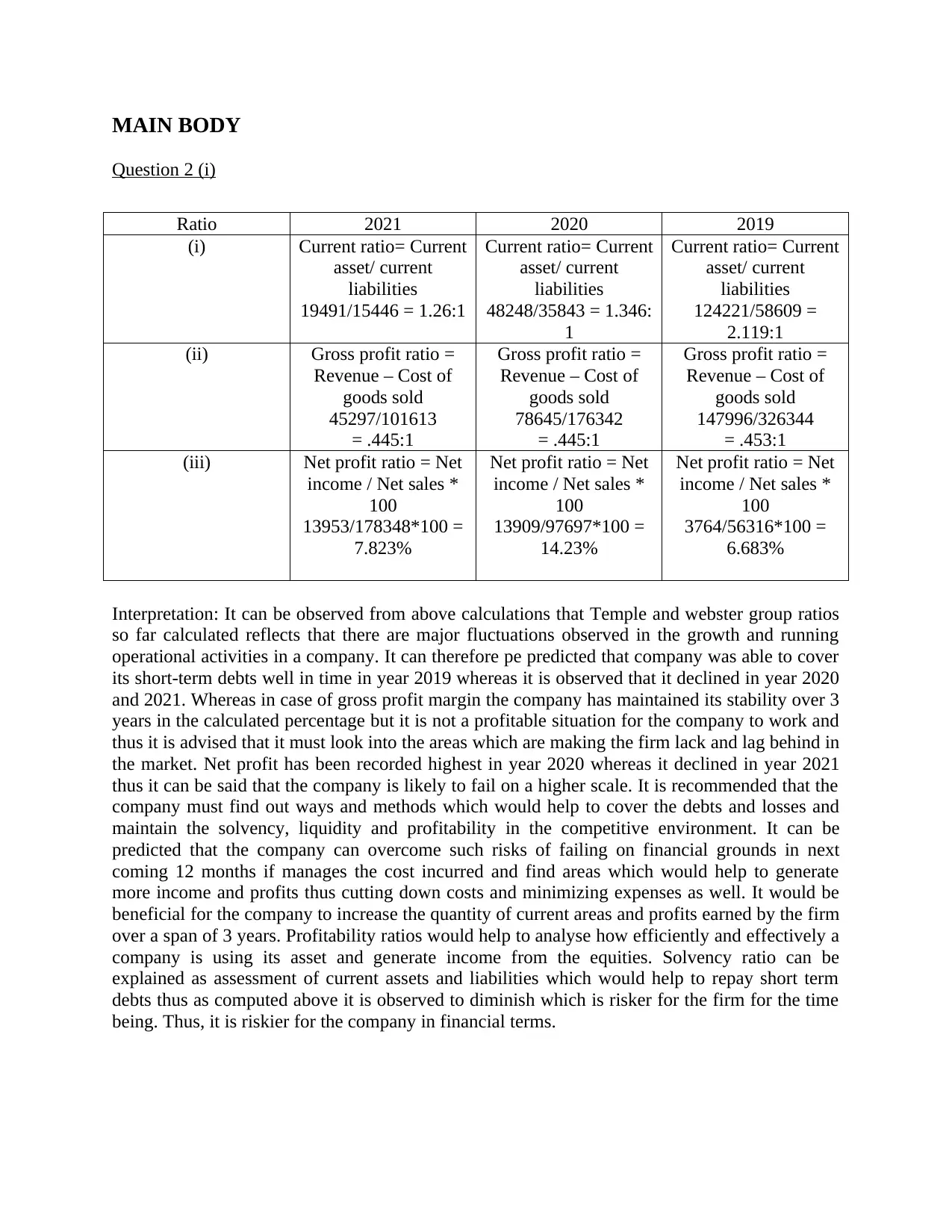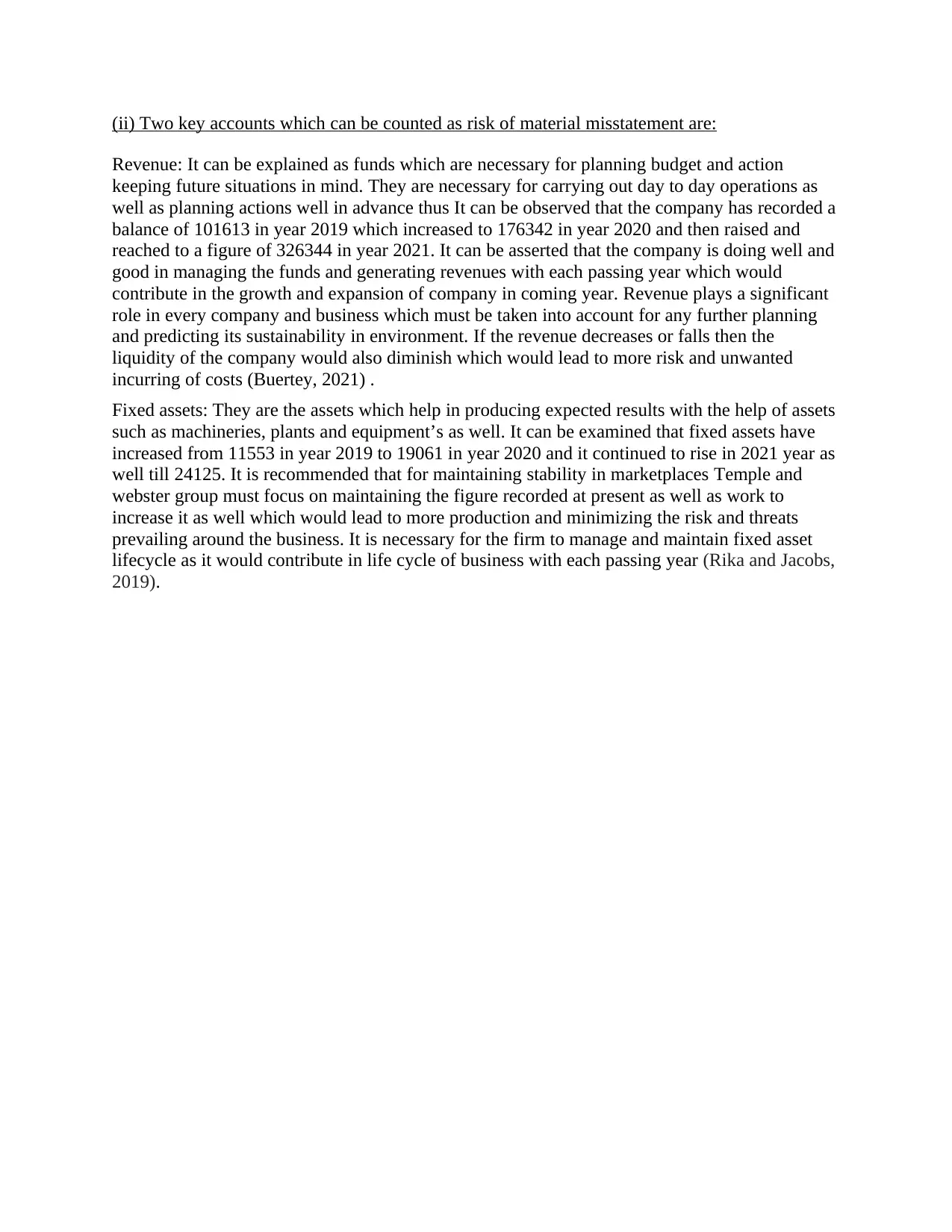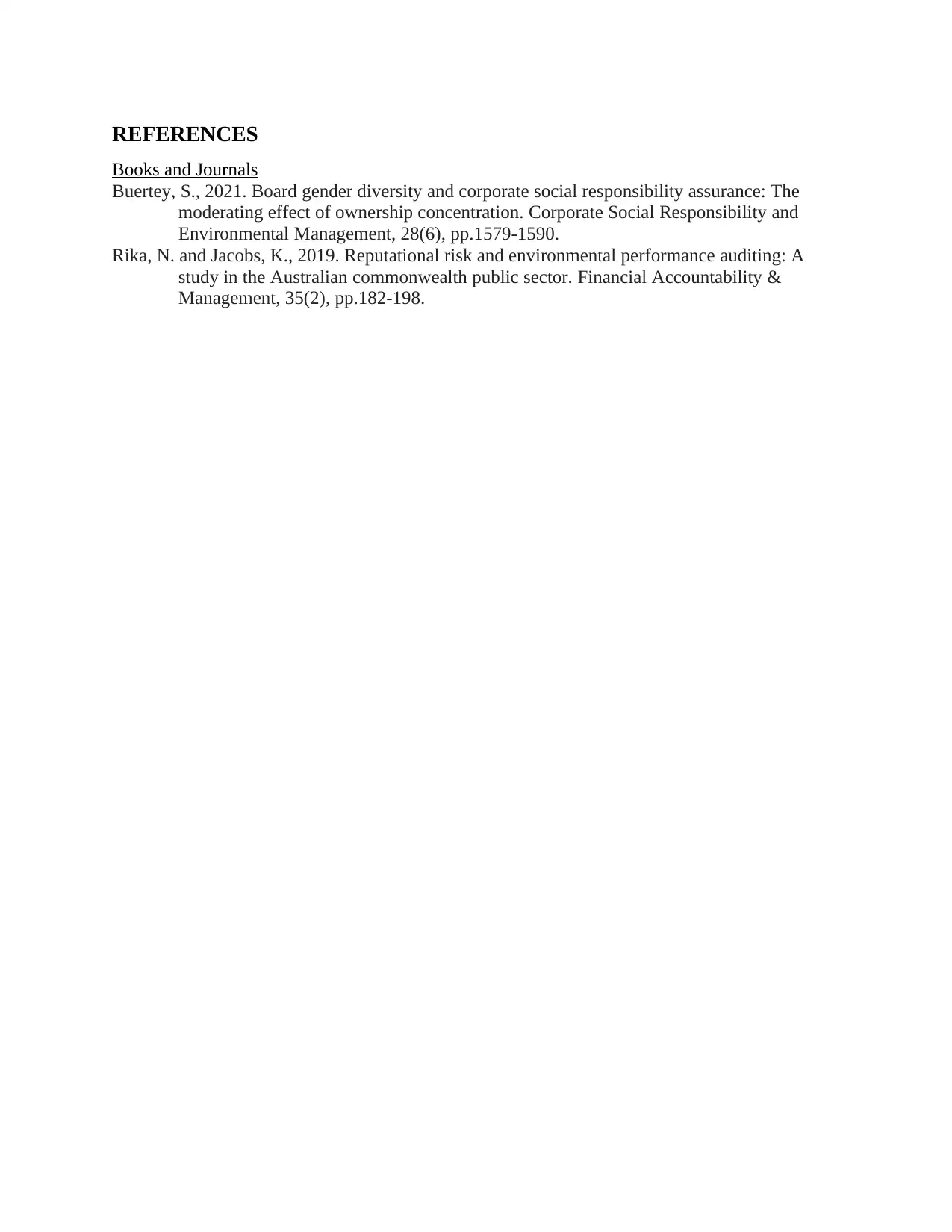Auditing and Assurance: Financial Analysis of Temple & Webster Group
VerifiedAdded on 2023/06/10
|5
|933
|128
Report
AI Summary
This report presents a financial analysis of Temple & Webster Group, focusing on auditing and assurance principles. The analysis includes a detailed examination of key financial ratios, such as current, gross profit, and net profit ratios, over a three-year period (2019-2021). The report interprets these ratios to assess the company's financial performance, identifying trends in solvency, liquidity, and profitability. Furthermore, it highlights two key accounts – revenue and fixed assets – and discusses their potential risks of material misstatement. The report recommends strategies to improve financial stability and performance, emphasizing the importance of managing costs, generating income, and maintaining the asset lifecycle.

AUDITING AND
ASSURANCE
ASSURANCE
Paraphrase This Document
Need a fresh take? Get an instant paraphrase of this document with our AI Paraphraser

Table of Contents
MAIN BODY.............................................................................................................................3
Question 2 (i).....................................................................................................................................3
(ii) Two key accounts which can be counted as risk of material misstatement are:............................4
REFERENCES.....................................................................................................................................6
MAIN BODY.............................................................................................................................3
Question 2 (i).....................................................................................................................................3
(ii) Two key accounts which can be counted as risk of material misstatement are:............................4
REFERENCES.....................................................................................................................................6

MAIN BODY
Question 2 (i)
Ratio 2021 2020 2019
(i) Current ratio= Current
asset/ current
liabilities
19491/15446 = 1.26:1
Current ratio= Current
asset/ current
liabilities
48248/35843 = 1.346:
1
Current ratio= Current
asset/ current
liabilities
124221/58609 =
2.119:1
(ii) Gross profit ratio =
Revenue – Cost of
goods sold
45297/101613
= .445:1
Gross profit ratio =
Revenue – Cost of
goods sold
78645/176342
= .445:1
Gross profit ratio =
Revenue – Cost of
goods sold
147996/326344
= .453:1
(iii) Net profit ratio = Net
income / Net sales *
100
13953/178348*100 =
7.823%
Net profit ratio = Net
income / Net sales *
100
13909/97697*100 =
14.23%
Net profit ratio = Net
income / Net sales *
100
3764/56316*100 =
6.683%
Interpretation: It can be observed from above calculations that Temple and webster group ratios
so far calculated reflects that there are major fluctuations observed in the growth and running
operational activities in a company. It can therefore pe predicted that company was able to cover
its short-term debts well in time in year 2019 whereas it is observed that it declined in year 2020
and 2021. Whereas in case of gross profit margin the company has maintained its stability over 3
years in the calculated percentage but it is not a profitable situation for the company to work and
thus it is advised that it must look into the areas which are making the firm lack and lag behind in
the market. Net profit has been recorded highest in year 2020 whereas it declined in year 2021
thus it can be said that the company is likely to fail on a higher scale. It is recommended that the
company must find out ways and methods which would help to cover the debts and losses and
maintain the solvency, liquidity and profitability in the competitive environment. It can be
predicted that the company can overcome such risks of failing on financial grounds in next
coming 12 months if manages the cost incurred and find areas which would help to generate
more income and profits thus cutting down costs and minimizing expenses as well. It would be
beneficial for the company to increase the quantity of current areas and profits earned by the firm
over a span of 3 years. Profitability ratios would help to analyse how efficiently and effectively a
company is using its asset and generate income from the equities. Solvency ratio can be
explained as assessment of current assets and liabilities which would help to repay short term
debts thus as computed above it is observed to diminish which is risker for the firm for the time
being. Thus, it is riskier for the company in financial terms.
Question 2 (i)
Ratio 2021 2020 2019
(i) Current ratio= Current
asset/ current
liabilities
19491/15446 = 1.26:1
Current ratio= Current
asset/ current
liabilities
48248/35843 = 1.346:
1
Current ratio= Current
asset/ current
liabilities
124221/58609 =
2.119:1
(ii) Gross profit ratio =
Revenue – Cost of
goods sold
45297/101613
= .445:1
Gross profit ratio =
Revenue – Cost of
goods sold
78645/176342
= .445:1
Gross profit ratio =
Revenue – Cost of
goods sold
147996/326344
= .453:1
(iii) Net profit ratio = Net
income / Net sales *
100
13953/178348*100 =
7.823%
Net profit ratio = Net
income / Net sales *
100
13909/97697*100 =
14.23%
Net profit ratio = Net
income / Net sales *
100
3764/56316*100 =
6.683%
Interpretation: It can be observed from above calculations that Temple and webster group ratios
so far calculated reflects that there are major fluctuations observed in the growth and running
operational activities in a company. It can therefore pe predicted that company was able to cover
its short-term debts well in time in year 2019 whereas it is observed that it declined in year 2020
and 2021. Whereas in case of gross profit margin the company has maintained its stability over 3
years in the calculated percentage but it is not a profitable situation for the company to work and
thus it is advised that it must look into the areas which are making the firm lack and lag behind in
the market. Net profit has been recorded highest in year 2020 whereas it declined in year 2021
thus it can be said that the company is likely to fail on a higher scale. It is recommended that the
company must find out ways and methods which would help to cover the debts and losses and
maintain the solvency, liquidity and profitability in the competitive environment. It can be
predicted that the company can overcome such risks of failing on financial grounds in next
coming 12 months if manages the cost incurred and find areas which would help to generate
more income and profits thus cutting down costs and minimizing expenses as well. It would be
beneficial for the company to increase the quantity of current areas and profits earned by the firm
over a span of 3 years. Profitability ratios would help to analyse how efficiently and effectively a
company is using its asset and generate income from the equities. Solvency ratio can be
explained as assessment of current assets and liabilities which would help to repay short term
debts thus as computed above it is observed to diminish which is risker for the firm for the time
being. Thus, it is riskier for the company in financial terms.
⊘ This is a preview!⊘
Do you want full access?
Subscribe today to unlock all pages.

Trusted by 1+ million students worldwide

(ii) Two key accounts which can be counted as risk of material misstatement are:
Revenue: It can be explained as funds which are necessary for planning budget and action
keeping future situations in mind. They are necessary for carrying out day to day operations as
well as planning actions well in advance thus It can be observed that the company has recorded a
balance of 101613 in year 2019 which increased to 176342 in year 2020 and then raised and
reached to a figure of 326344 in year 2021. It can be asserted that the company is doing well and
good in managing the funds and generating revenues with each passing year which would
contribute in the growth and expansion of company in coming year. Revenue plays a significant
role in every company and business which must be taken into account for any further planning
and predicting its sustainability in environment. If the revenue decreases or falls then the
liquidity of the company would also diminish which would lead to more risk and unwanted
incurring of costs (Buertey, 2021) .
Fixed assets: They are the assets which help in producing expected results with the help of assets
such as machineries, plants and equipment’s as well. It can be examined that fixed assets have
increased from 11553 in year 2019 to 19061 in year 2020 and it continued to rise in 2021 year as
well till 24125. It is recommended that for maintaining stability in marketplaces Temple and
webster group must focus on maintaining the figure recorded at present as well as work to
increase it as well which would lead to more production and minimizing the risk and threats
prevailing around the business. It is necessary for the firm to manage and maintain fixed asset
lifecycle as it would contribute in life cycle of business with each passing year (Rika and Jacobs,
2019).
Revenue: It can be explained as funds which are necessary for planning budget and action
keeping future situations in mind. They are necessary for carrying out day to day operations as
well as planning actions well in advance thus It can be observed that the company has recorded a
balance of 101613 in year 2019 which increased to 176342 in year 2020 and then raised and
reached to a figure of 326344 in year 2021. It can be asserted that the company is doing well and
good in managing the funds and generating revenues with each passing year which would
contribute in the growth and expansion of company in coming year. Revenue plays a significant
role in every company and business which must be taken into account for any further planning
and predicting its sustainability in environment. If the revenue decreases or falls then the
liquidity of the company would also diminish which would lead to more risk and unwanted
incurring of costs (Buertey, 2021) .
Fixed assets: They are the assets which help in producing expected results with the help of assets
such as machineries, plants and equipment’s as well. It can be examined that fixed assets have
increased from 11553 in year 2019 to 19061 in year 2020 and it continued to rise in 2021 year as
well till 24125. It is recommended that for maintaining stability in marketplaces Temple and
webster group must focus on maintaining the figure recorded at present as well as work to
increase it as well which would lead to more production and minimizing the risk and threats
prevailing around the business. It is necessary for the firm to manage and maintain fixed asset
lifecycle as it would contribute in life cycle of business with each passing year (Rika and Jacobs,
2019).
Paraphrase This Document
Need a fresh take? Get an instant paraphrase of this document with our AI Paraphraser

REFERENCES
Books and Journals
Buertey, S., 2021. Board gender diversity and corporate social responsibility assurance: The
moderating effect of ownership concentration. Corporate Social Responsibility and
Environmental Management, 28(6), pp.1579-1590.
Rika, N. and Jacobs, K., 2019. Reputational risk and environmental performance auditing: A
study in the Australian commonwealth public sector. Financial Accountability &
Management, 35(2), pp.182-198.
Books and Journals
Buertey, S., 2021. Board gender diversity and corporate social responsibility assurance: The
moderating effect of ownership concentration. Corporate Social Responsibility and
Environmental Management, 28(6), pp.1579-1590.
Rika, N. and Jacobs, K., 2019. Reputational risk and environmental performance auditing: A
study in the Australian commonwealth public sector. Financial Accountability &
Management, 35(2), pp.182-198.
1 out of 5
Related Documents
Your All-in-One AI-Powered Toolkit for Academic Success.
+13062052269
info@desklib.com
Available 24*7 on WhatsApp / Email
![[object Object]](/_next/static/media/star-bottom.7253800d.svg)
Unlock your academic potential
Copyright © 2020–2025 A2Z Services. All Rights Reserved. Developed and managed by ZUCOL.





